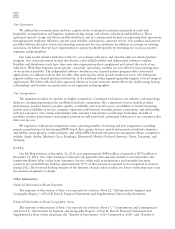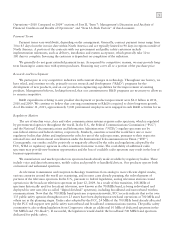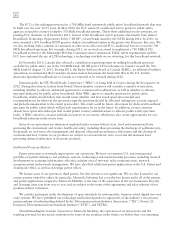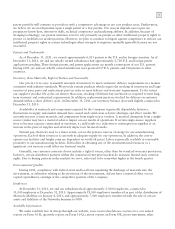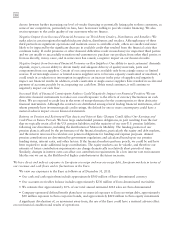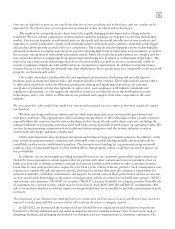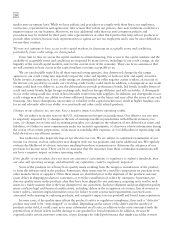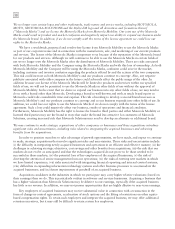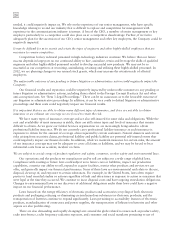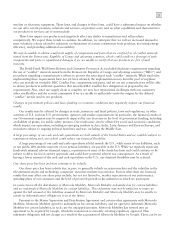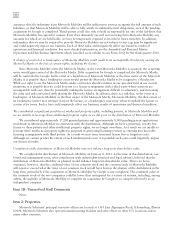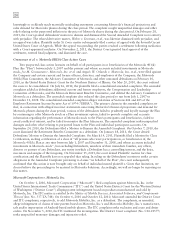Motorola 2011 Annual Report Download - page 20
Download and view the complete annual report
Please find page 20 of the 2011 Motorola annual report below. You can navigate through the pages in the report by either clicking on the pages listed below, or by using the keyword search tool below to find specific information within the annual report.
14
similar anti-corruption laws. While we have policies and procedures to comply with these laws, our employees,
contractors, representatives and agents may take actions that violate our policies. Any such violations could have a
negative impact on our business. Moreover, we face additional risks that our anti-corruption policies and
procedures may be violated by third party sales representatives or other third parties that help sell our products or
provide other services, because such representatives or agents are not our employees and it may be more difficult to
oversee their conduct.
We may not continue to have access to the capital markets for financing on acceptable terms and conditions,
particularly if our credit ratings are downgraded.
From time to time we access the capital markets to obtain financing. Our access to the capital markets and the
availably of acceptable terms and conditions are impacted by many factors, including: (i) our credit ratings, (ii) the
liquidity of the overall capital markets, and (iii) the current state of the economy. There can be no assurances that
we will continue to have access to the capital markets on terms acceptable to us.
We are rated middle triple B by all three national rating agencies. Any downward changes by the rating
agencies to our credit rating may negatively impact the value and liquidity of both our debt and equity securities.
Under certain circumstances, if our credit ratings are downgraded or other negative action is taken, an increase in
the interest rate payable by us under our revolving credit facility could result. In addition, a downgrade in our credit
ratings could limit our ability to: access the debt markets; provide performance bonds, bid bonds, standby letters of
credit and surety bonds; hedge foreign exchange risk; fund our foreign affiliates; and sell receivables. A downgrade
in our credit rating could also result in less favorable trade terms with suppliers. In addition, any downgrades in our
credit ratings may affect our ability to obtain additional financing in the future and may affect the terms of any such
financing. Any future disruptions, uncertainty or volatility in the capital markets may result in higher funding costs
for us and adversely affect our ability to access funds and other credit related products.
Changes in our effective tax rate may have a negative impact on future operating results.
We are subject to income taxes in the U.S. and numerous foreign tax jurisdictions. Our effective tax rate may
be negatively impacted by (i) changes in the mix of earnings taxable in jurisdictions with different statutory tax
rates, (ii) changes in tax laws and accounting principles, (iii) changes in the valuation of our deferred tax assets and
liabilities, (iv) failure to meet commitments under tax incentive agreements, (v) discovery of new information during
the course of tax return preparation, (vi)increases in nondeductible expenses, or (vii) difficulties in repatriating cash
held abroad in a tax-efficient manner.
Tax audits may also negatively impact our effective tax rate. We are subject to continued examination of our
income tax returns, and tax authorities may disagree with our tax positions and assess additional tax. We regularly
evaluate the likelihood of adverse outcomes resulting from these examinations to determine the adequacy of our
provision for income taxes. There can be no assurance that the outcomes from these continuing examinations will
not have a negative impact on future operating results.
If the quality of our products does not meet our customers’ expectations or regulatory or industry standards, then
our sales and operating earnings, and ultimately our reputation, could be negatively impacted.
Some of the products we sell may have quality issues resulting from the design or manufacture of the product,
or from the software used in the product. Sometimes, these issues may be caused by components we purchase from
other manufacturers or suppliers. Often these issues are identified prior to the shipment of the products and may
cause delays in shipping products to customers, or even the cancellation of orders by customers. Sometimes, we
discover quality issues in the products after they have been shipped to our customers, requiring us to resolve such
issues in a timely manner that is the least disruptive to our customers. Such pre-shipment and post-shipment quality
issues can have legal and financial ramifications, including: delays in the recognition of revenue, loss of revenue or
future orders, customer-imposed penalties on us for failure to meet contractual requirements, increased costs
associated with repairing or replacing products, and a negative impact on our goodwill and brand name reputation.
In some cases, if the quality issue affects the product’s safety or regulatory compliance, then such a “defective”
product may need to be “stop-shipped” or recalled. Depending on the nature of the defect and the number of
products in the field, it could cause us to incur substantial recall costs, in addition to the costs associated with the
potential loss of future orders and the damage to our goodwill or brand reputation. In addition, we may be
required, under certain customer contracts, to pay damages for failed performance that might exceed the revenue


